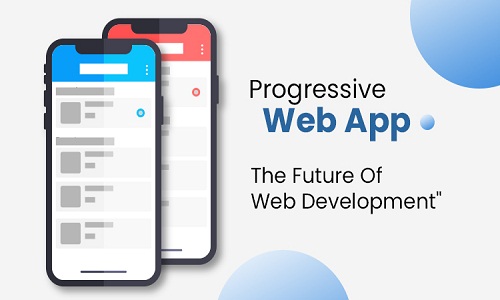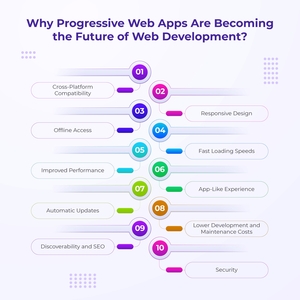
Table of Contents
Progressive Web Apps (PWAs) have gained significant traction in recent years and are considered by many to be the future of web development.
They combine the best features of both web and mobile applications, providing an enhanced user experience, better performance, and improved accessibility.
Let’s delve into the details of why PWAs are becoming the future of web development:

- Cross-Platform Compatibility
- Responsive Design
- Offline Access
- Fast Loading Speeds
- Improved Performance
- App-Like Experience
- Automatic Updates
- Lower Development and Maintenance Costs
- Discoverability and SEO
- Security
1. Cross-Platform Compatibility:
One of the key reasons for the rise of PWAs is their ability to work seamlessly across different platforms and devices, including desktops, smartphones, tablets, and even emerging technologies like smart TVs.
Developers can create a single PWA that adapts to various screen sizes and resolutions, reducing the need for separate codebases for different platforms.
This saves development time and resources, making PWAs an efficient choice for reaching a broader audience.
2. Responsive Design
Progressive Web Apps are designed with a responsive layout that adjusts to different screen sizes and orientations.
PWAs are web applications that leverage modern web technologies to deliver app-like experiences to users.
Responsive design in PWAs involves designing and developing the app in a way that it adapts gracefully to different devices, including desktops, tablets, and smartphones.
This ensures a consistent and optimal user experience across devices, eliminating the need for users to install multiple apps for various platforms.
Here are some key principles and practices to consider when implementing responsive design in Progressive Web Apps.
- Responsive Images
- Flexible Typography
- Progressive Enhancement
- Performance Optimization
- User-Centric Design
- Testing Across Devices
- Touch-Friendly Design
- Breakpoints
- Viewport Meta Tag
By implementing responsive web design principles in your Progressive Web App, you can create an inclusive and user-friendly experience across a wide range of devices, making your app accessible to a larger audience.
3. Offline Access
PWAs incorporate service workers, which are scripts that run in the background and cache resources.
This enables PWAs to function offline or in low-network conditions, providing users with uninterrupted access to content and functionality.
Offline support is a crucial feature, especially in areas with unreliable internet connectivity.
4. Fast Loading Speeds
PWAs are designed to load quickly, enhancing user engagement and reducing bounce rates.
Service workers cache resources such as HTML, CSS, and JavaScript, allowing PWAs to load instantly when users revisit the app.
This improved performance leads to better user satisfaction and encourages longer interaction with the app.
Improving fast loading speeds in Progressive Web Apps (PWAs) is crucial to provide a smooth user experience and encourage user engagement.
Here are some strategies you can implement to enhance loading speeds in PWAs:
- Optimize Critical Rendering Path
- Caching Strategies
- Lazy Loading
- Server-Side Optimization
- Prefetching and Preloading
- Measure and Monitor Performance
5. Improved Performance
PWAs are built with modern web technologies and best practices, resulting in smoother animations, transitions, and overall user interactions.
This enhanced performance contributes to a more polished and professional user experience, rivaling that of native applications.
Some strategies you can implement to achieve improved performance in PWAs:
- Optimize Images and Media
- Minimize and Bundle Code
- Caching and Offline Support
- Network Performance
- Reduce Third-Party Dependencies
- Use Web Workers
- Lazy Loading and Dynamic Loading
- Progressive Enhancement
- Optimize Animations and Transitions
- Performance Monitoring and Testing
- Responsive Design
- Reduce Time to First Byte
6. App-Like Experience
PWAs offer an app-like experience within a web browser. They can be installed on a user’s home screen without the need to go through app stores, reducing friction and encouraging adoption.
Once installed, PWAs launch in their own window, providing a distraction-free environment and blurring the line between web and native apps.
7. Automatic Updates
PWAs are updated automatically in the background, ensuring that users always have access to the latest features, bug fixes, and security enhancements.
This eliminates the need for users to manually update their apps through app stores, streamlining the user experience and reducing the risk of using outdated software.
8. Lower Development and Maintenance Costs
Developing a single PWA for multiple platforms can significantly reduce development and maintenance costs compared to building separate native apps for each platform.
This cost-effectiveness makes PWAs an attractive option, especially for startups, small businesses, and organizations with limited resources.
9. Discoverability and SEO
PWAs are easily discoverable through search engines, as they are essentially websites.
This improves their visibility and allows users to find and access the app through search queries.
Additionally, PWAs can be shared via URL links, social media, or email, further increasing their reach.
10. Security
PWAs are served over HTTPS by default, ensuring that data transmission between the user and the app is secure.
Improving security in Progressive Web Apps (PWAs) is crucial to ensure the protection of user data and maintain the integrity of your application.
Here are some steps you can take to enhance security in your PWAs:
- Use HTTPS
- Content Security Policy (CSP)
- Secure Authentication and Authorization
- Input Validation
- Cross-Origin Resource Sharing (CORS)
- Service Workers Security
- Sensitive Data Handling
- Regular Updates
- Offline Data Security
- Regular Security Audits
- Monitoring and Logging
- Penetration Testing
- User Privacy
- Security Training
- Third-Party Integration
By following these steps, you can significantly improve the security of your Progressive Web App and provide a safer and more reliable experience for your users.
Conclusion:
Progressive Web Apps offer a powerful combination of cross-platform compatibility, responsive design, offline access, fast loading speeds, improved performance, app-like experiences, automatic updates, and cost-effectiveness.
These features collectively contribute to the growing popularity of PWAs and position them as a significant and promising trend in the future of web development.
As web technologies continue to evolve, PWAs are likely to play a crucial role in shaping the way users interact with online content and services.


Be the first to comment